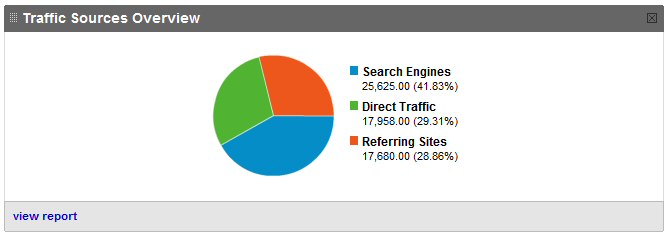|
 |
Google Analytics for software sellers Tips for maximising the performance of your website |
|||||
 | |||||||
So you are a software developer with a finished product, your own website, a payment system in place, you have been promoting your software, maybe even running a few ad campaigns, and it's not selling enough to buy a new ferrari. How can you sell more copies, improve your website and retire rich and happy?*
Well one thing is for sure, if you aren't using google analytics or something similar on your website, you need to be.
What is google analytics?
Google analytics is a free set of tools that google makes available to website owners. If you have a google adwords account, you will have an 'analytics' tab at the top of your adwords homepage. If not, you can sign up for the service here: http://www.google.com/analytics/
Of course, analytics comes with it's own help system and tutorials, but I thought it might be a good idea to lay out a few tips for people who are overwhelmed by it all, and who are trying to do the same thing I am (running a tiny one-man software business). You can spend a lot of time fiddling in analytics without realizing where the really cool options are. So here are my top tips for getting the most out of google analytics:
Tip #1. Note your main sources of traffic

On the main analytics dashboard you should see something like this. If not, you can click the Traffic Sources button on the left of the screen. This data is VERY important. If you note nothing else from your analytics data, note this. It might be that 75% of your hits come from referring sites, in which case you might want to see why this is (maybe your website is very unfriendly to search engine spiders). You might have almost all of it from search engines, in which case maybe you should concentrate on building up some coverage with high traffic sites. Note that I've got a lot of direct traffic. This is mainly people clicking on the 'buy now' buttons in my games, which explains why there is no referring link.
Tip #2. Set up some goals
Analytics is interesting without goals, but for ecommerce, you really need to identify whether you are getting lots of visitors, or lots of quality visitors. For software devs, this is probably defined by how many people buy the product. I track the number of hits I get on my register pages (not confirmed sales), and have defined goals for several of the top selling games. You really need to do this. Everything else flows from this.
Tip #3. Look at your bounce rate.
The bounce rate is the number of people who visit your site briefly then go elsewhere. This is generally bad, as you want people to hang around, maybe buy stuff. However, some pages will always have a high bounce rate. The demo download page and the buy page, obviously are natural dead ends (hopefully!), but the homepage for your software needs to encourage people to go on to the download or buy pages. If 95% of viitors to your homepage bounce out, your homepage content is BAD or you are getting the wrong visitors.

If you click on the left hand button that says Content and then Top Content, you will see a table like the one above. You can sort it by bounce rate (but ignore wild rates on pages with low traffic counts, as they are statistically irrelevant). Check your main product home page bouce rates are low. If they are too high, you might need to improve that page, or give it some links to other products to try and 'catch' the interest of those bouncing visitors. very helpfully, analytics will let you instantly compare each pages bounce rates against the general site rate, which can be a handy metric.
| Kudos 2 | Rock Legend | Democracy 2 | Planetary Defense | Ancient Empires | Starship Tycoon |
Tip #4. Not all referring sites are equal.
Lets assume 3 big name websites link to your site, and you know from your normal traffic logs that they all send a decent amount of clicks your way. Is there more information we can get from that? Sure! Click the left hand Traffic Sources button, then Referring Sites underneath to get a table like the one below:

There's a lot of interesting data here. It looks like rockpapershotgun is sending me people who are spending more time on site than the game advertising traffic. Also, stumbleupons traffic seems to have a very low bounce rate. You should definitely check the top twenty or thirty referrers this way. You might be surprised how transient and useless traffic from some sites are, and how fantastically sticky traffic from other sites is. If you do this with advertising campaigns, you can tell how much each advertising spot is really worth.
Tip #5. You can compare visitors from different countries.
Click Visitors on the left, then Map Overlay to get a funky nice chart. But forget the chart, and take a look at the table below it. If you have goals set up you can click the goals button at the top of the table and see something like this:

You can see that the overall goal conversion rate does vary. It seems like people from Poland are pretty keen to visit the buy pages in general (I'd have to cross-reference this with my sales data to see if this translates into actual sales, or people just checking the price), and prefer Kudos to the other games. No surprise to see the strategy-mad Germans like my political strategy game (Democracy 2). If you run different ad campaigns in different territories, you really NEED this data. You can target ad budgets according to how popular the product is with different countries.
Tip #6. You can track outgoing links.
Yes you really can. You just need to stick some spangly javascript around your outgoing links. you should really do this for for your buy buttons, or any link that goes outwards about which you have concerns you are throwing away traffic. (if you do a link-swap, this might be worth checking out). Analytics will let you name the outgoing link however you like, and you can then see it in your charts like this (I call them 'outgoing').

Note the bottom strip. You can click on Content, then Top Content, then filter the whole list by a unique name (outgoing) to see just those pages put side by side. Neat huh?
Tip #7 You can track navigation into and out of pages.
Click Content then Top Content again. Then select one of the pages by clicking it's name in the list. On the next page, click on Navigation Summary, to get details like the ones below:

Note that this is all for a specific page. It tells me where people came from, and where they went next. It looks like 10% of those visitors went back to democracy2/index.html after visiting this page, and 43% left the site altogether. These stats are important. If you look at them for your buy pages, you can see which routes people took to get there, and if you have any pages such as a 'questions about buying' link on the order page, you can see how many people checked that out. I notice on some of my buy pages that people click on a 'support' link from there, presumably to see if there are any known software incompatibilities before they order. I make all my games DRM-free, and I know exactly how many people click on the DRM-free link on my order pages. Obviously there are tons of uses of this data, but you have to know it's there, and actually USE it :D.
There is a LOT MORE to analytics than this. This is just a few of the features I found cool, and thought it was worth pointing them out to fellow developers. Keep fiddling to find out even more (check out the animated stuff over time :D).
*I'm still working on that bit
If you are a game developer programming a game with explosions in you might find this useful.
| Kudos 2 | Rock Legend | Democracy 2 | Planetary Defense | Ancient Empires | Starship Tycoon |